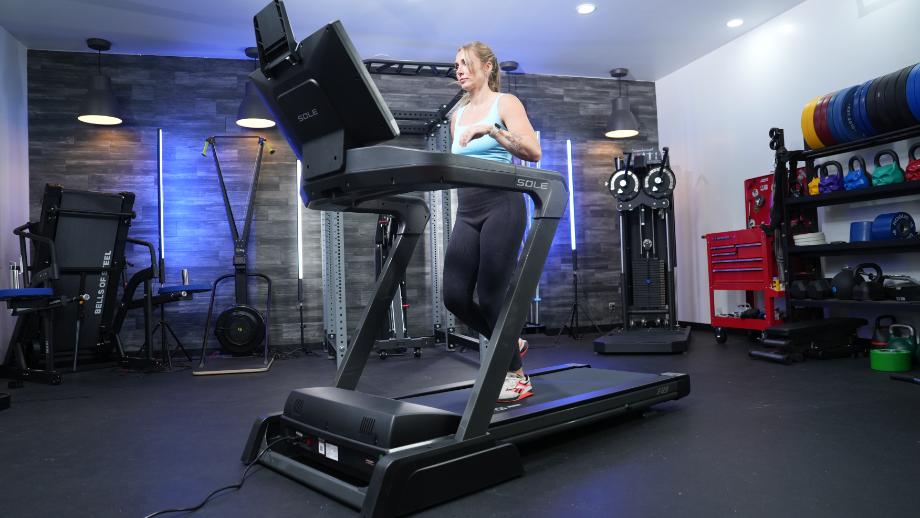I’m sure you’ve tried the burpees exercise at some point in your fitness journey. I’m confident of this because you see burpees everywhere—they’re included in exercise programs for children, CrossFit workouts, HIIT workouts, and pretty much every personal trainer (myself included) adds them to calisthenic workout routines for their clients.
While extremely popular—or polarizing—you may have one unanswered question: What muscles do burpees work? Luckily, I’m a certified personal trainer with a helpful guide to answer your burning burpees questions. I’ll start by explaining how to do a burpee with the correct form before discussing the muscle groups activated (and their functions). Then, I’ll go through five benefits of burpees and give a few sample burpees workouts to try.
RELATED: At-Home Bodyweight Workout
Ready to burn calories with this challenging bodyweight exercise? Read on to learn more.
How To Do A Burpee
To perform a burpee, all you really need is your body weight. Of course, there are a few steps to follow for doing the exercise with the correct form, but no additional equipment is required. If you’re new to burpees, take each step slowly before increasing your speed.
How to do it:
- Stand tall with your feet shoulder-width apart. Your arms should be down by your sides and your head in a neutral position.
- Brace your core and squeeze your glutes.
- Perform a hip hinge movement to lower your upper body toward the ground and place your hands on the floor in front of you.
- Hop your feet backward so that you’re in the high plank position (aka the push-up position).
- Lightly touch your chest, quads, and abdominal region to the ground by lowering your torso down.
- Push through your hands to return to the high plank position, and then hop your feet forward.
- Jump up and raise your arms toward the ceiling to complete the movement.
- Land on both feet, adjusting your stance as needed. (You’ll want to bring your arms to your sides before doing the next rep.)
- Continue for the desired number of repetitions.

Modifications
- Dial it back: Instead of jumping up at the end of each rep, step back up into the standing position one leg at a time, which places less stress on your knees. Beginners can also put their hands on an elevated surface (like a flat bench or one of the best plyo boxes) instead of the floor.
- Make it harder: You can do more reps or increase your speed. Alternatively, try weighted burpees by holding a pair of dumbbells in your hands, or wearing a weighted vest. Burpee box jumps are another progression. Instead of jumping vertically, you’ll increase your power and explosiveness by jumping forward onto a box.

What Muscles Do Burpees Work?
Burpees work nearly every major muscle group in the body, including the quads, hamstrings, calves, glutes, core, shoulders, chest, and triceps. Here’s a breakdown of each muscle:
- Quadriceps: The quadriceps are responsible for knee extension1, hip flexion, maintenance of posture, proper stage of step/gait cycle, and maintenance of patellar stability.
- Hamstrings: The hamstring muscle group2 plays a prominent role in hip extension (posterior movement of the femur) and knee flexion (posterior movement of the tibia and fibula).
- Calves: The calf muscles are responsible for plantar flexion of the foot and ankle3.
- Glutes: Together, the three gluteal muscles extend and externally rotate the thigh4. The gluteus maximus (the largest of the three) is the chief antigravity muscle during sitting by counteracting and controlling the hip flexion.
- Abdominal muscles: The abdominal muscles5 assist in the process of respiration, protect inner organs, provide postural support, and serve to flex, extend, and rotate the trunk of the body.
- Shoulders: The deltoid muscles have a wide range of functions, including abduction, adduction, flexion, extension, internal and external rotation6.
- Chest: The pectoral muscles7 are responsible for flexion, adduction, and internal rotation of the humerus, stabilization of the scapula, and elevating and depressing the thorax bones.
- Triceps: The primary function of the triceps is the extension of the elbow joint8.
What Are the Benefits of Burpees?
Why should you do burpees in the first place? They improve your cardio fitness, burn calories, work the entire body, don’t require any equipment, and can be adapted to different fitness levels. See below:
They Help Improve Your Cardiovascular Fitness
There are several benefits of cardio exercises and increasing your heart rate through explosive HIIT and calisthenic movements. You may sleep better, have better lung health, reduce stress levels, and improve your mental health.
You’ll often see burpees in high-intensity interval training (HIIT) workouts, and a 2022 Journal of Exercise Science & Fitness9 study found that HIIT workouts also may help improve bone metabolism.
RELATED: Benefits of HIIT Training
They Help Burn Calories
If weight loss is your goal, burpees might be your new best friend, as they help burn more calories. Of course, there’s more to it than just burpees every day—you’ll also need to be in a calorie deficit—but this high-intensity exercise is a fantastic choice since the high energy generated from this dynamic movement heats your fat-burning metabolism.

They Work Your Whole Body
As you saw above, burpees can be a full-body workout at home. They target the lower body (quads, hamstrings, calves, and glutes) and the upper body (chest, shoulders, triceps, and abs). Although you usually see burpees in cardio workouts, they can also help to build muscle because you’re using your body weight as resistance to get up and down from the ground.
They Don’t Require Equipment
Because you don’t need any equipment for burpees, you can do them from anywhere. Some full-body exercises (such as back squats or deadlifts) are great, but they require you to be in a gym or at home (provided you have the right equipment).
All you need is a little bit of space, so do burpees in your home office, a park, or even your hotel room while traveling.
They Can Be Adapted to Different Fitness Levels
One reason I love burpees is that there are several burpee variations. Regardless of your fitness level, you can find an option that works for you. If standard burpees are too difficult at first, you can try doing them slowly without the jump at the end or place your hands on an elevated surface.

Hold a pair of dumbbells or jump onto a plyometric box instead of jumping vertically for a more challenging exercise.
Sample Burpees Workouts
Now that you know how to do burpees with proper form and what muscles burpees work, let’s jump into some sample burpees workouts. Here are three workouts for different fitness levels that I recommend to clients:
Burpees Workout For Beginners
Before you start your beginner burpees workout, you’ll want to warm up first. Spend five minutes doing cardio, then do dynamic exercises such as jump squats, push-up variations, squat thrusts, tuck jumps, leg swings, and more.
Then, do five rounds of the following:
Beginner Burpees Workout
5 Rounds
- 10 burpees
- 90 seconds of rest
The whole workout should last roughly 10 minutes. I’ve given you plenty of recovery time because performing burpees as a beginner can take a lot out of you. To advance, either do more burpees, reduce your rest time, or progress to the intermediate burpees workout below.
Intermediate Burpees Workout
To begin, perform a similar warm-up to the one listed above. Then, do the below intermediate burpees workout.
Intermediate Burpees Workout
For time:
- 100 weighted burpees or burpee box jumps
The aim is to complete this as quickly as possible while still maintaining the correct form. Keep a stopwatch or a timer on your phone and record how long it takes. The next time you attempt it, try to beat that time. You’re in charge of your rest times, so you can either go at a slower pace and have less rest or go all out for 20 or more reps and have longer rest periods.
Advanced Burpees Workout
My advanced burpees workout is a true test of your upper and lower body strength, as well as your cardiovascular fitness.
Do a similar warm-up to the above before doing the following:
Advanced Burpees Workout
- Do 1 burpee
- Sprint 75m
- Do 2 burpees
- Sprint 75m (back to the starting position)
- Do 3 burpees
- Sprint 75m
- And so on until you reach 20 reps of burpees
The goal is to keep adding one rep until you get to 20 burpees. You’ll want to make sure that you sprint between each set (and not jog or walk) and do each burpee with proper form.
If you’re wondering, the total number of reps you’ll do by the end of the workout (should you get there) is 210 burpees!
What Muscles Do Burpees Work? Final Thoughts
You arrived here with one question: What muscles do burpees work? The answer is the following:
- Quadriceps
- Hamstrings
- Calves
- Glutes
- Abdominal muscles
- Shoulders
- Chest
- Triceps

Yes, that’s right. Burpees work nearly every muscle in your body, which is why they’re extremely versatile. They don’t require any equipment and can be easily adapted to your fitness level. As grueling as they are, I’m not going to lie—I love them (and so do my clients).
To perform them, all you need is your body weight, but if you’re doing them for the first time, take each step slowly.
What Muscles Do Burpees Work? FAQs
Do burpees burn fat or muscle
Burpees burn calories, not fat or muscle. There’s a significant difference because you’re burning calories, but if you’re not in a caloric deficit, then you won’t burn fat. If you aim to lose weight, your nutrition is the key to success.
Ideally, you don’t want to burn muscle at all, regardless of your fitness goals. To prevent muscle loss, do strength training exercises and ensure you meet your protein requirements.
Should burpees be fast or slow?
Burpees can be fast or slow; there’s no right or wrong answer to this question. Many experienced gym-goers perform burpees quickly, but the downside is you can start to lose your form, especially when tired. If you’re new to burpees or find that doing them quicker isn’t for you (perhaps because of experience or previous injuries), do them slowly.
Which is better: squats or burpees?
Squats and burpees are both fantastic exercises, so I’m not going to choose one or the other. Ideally, you’d have both in your training regimen. As a certified personal trainer (CPT), I find that squats are better for working your lower body, especially when you add some resistance. Burpees hit your whole body—especially the upper body—more than squats. It’s worth noting that burpees are considered a cardio exercise, whereas squats are considered a leg-day strength exercise.
References
- Bordoni B, Varacallo M. Anatomy, Bony Pelvis and Lower Limb: Thigh Quadriceps Muscle. [Updated 2023 May 8]. In: StatPearls [Internet]. Treasure Island (FL): StatPearls Publishing; 2024 Jan-. Available from: https://www.ncbi.nlm.nih.gov/books/NBK513334/
- Rodgers CD, Raja A. Anatomy, Bony Pelvis and Lower Limb, Hamstring Muscle. [Updated 2023 Apr 1]. In: StatPearls [Internet]. Treasure Island (FL): StatPearls Publishing; 2024 Jan-. Available from: https://www.ncbi.nlm.nih.gov/books/NBK546688/
- Binstead JT, Munjal A, Varacallo M. Anatomy, Bony Pelvis and Lower Limb: Calf. [Updated 2023 May 23]. In: StatPearls [Internet]. Treasure Island (FL): StatPearls Publishing; 2024 Jan-. Available from: https://www.ncbi.nlm.nih.gov/books/NBK459362/
- Elzanie A, Borger J. Anatomy, Bony Pelvis and Lower Limb, Gluteus Maximus Muscle. [Updated 2023 Apr 1]. In: StatPearls [Internet]. Treasure Island (FL): StatPearls Publishing; 2024 Jan-. Available from: https://www.ncbi.nlm.nih.gov/books/NBK538193/
- Wade CI, Streitz MJ. Anatomy, Abdomen and Pelvis: Abdomen. [Updated 2023 Jul 24]. In: StatPearls [Internet]. Treasure Island (FL): StatPearls Publishing; 2024 Jan-. Available from: https://www.ncbi.nlm.nih.gov/books/NBK553104/
- McCausland C, Sawyer E, Eovaldi BJ, et al. Anatomy, Shoulder and Upper Limb, Shoulder Muscles. [Updated 2023 Aug 8]. In: StatPearls [Internet]. Treasure Island (FL): StatPearls Publishing; 2024 Jan-. Available from: https://www.ncbi.nlm.nih.gov/books/NBK534836/
- Baig MA, Bordoni B. Anatomy, Shoulder and Upper Limb, Pectoral Muscles. [Updated 2023 Aug 28]. In: StatPearls [Internet]. Treasure Island (FL): StatPearls Publishing; 2024 Jan-. Available from: https://www.ncbi.nlm.nih.gov/books/NBK545241/
- Tiwana MS, Sinkler MA, Bordoni B. Anatomy, Shoulder and Upper Limb, Triceps Muscle. [Updated 2023 Aug 28]. In: StatPearls [Internet]. Treasure Island (FL): StatPearls Publishing; 2024 Jan-. Available from: https://www.ncbi.nlm.nih.gov/books/NBK536996/
- Lu M, Li M, Yi L, Li F, Feng L, Ji T, Zang Y, Qiu J. Effects of 8-week High-Intensity Interval Training and Moderate-Intensity Continuous Training on Bone Metabolism in Sedentary Young Females. J Exerc Sci Fit. 2022 Apr;20(2):77-83. doi: 10.1016/j.jesf.2022.01.001. Epub 2022 Jan 5. PMID: 35096081; PMCID: PMC8762074.






